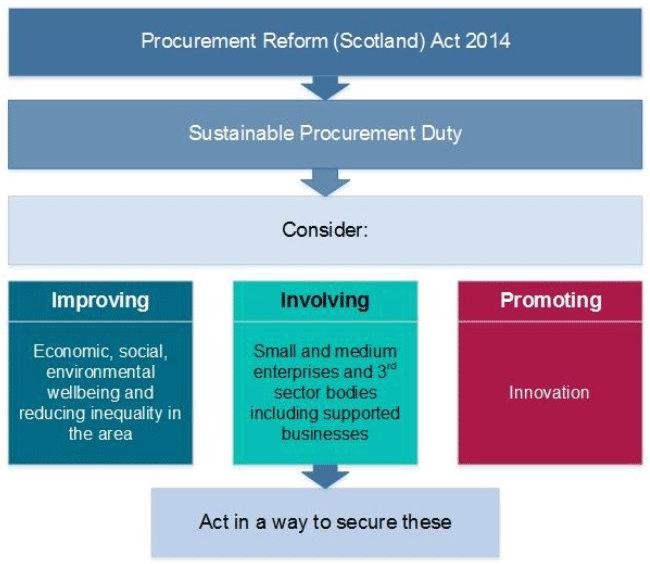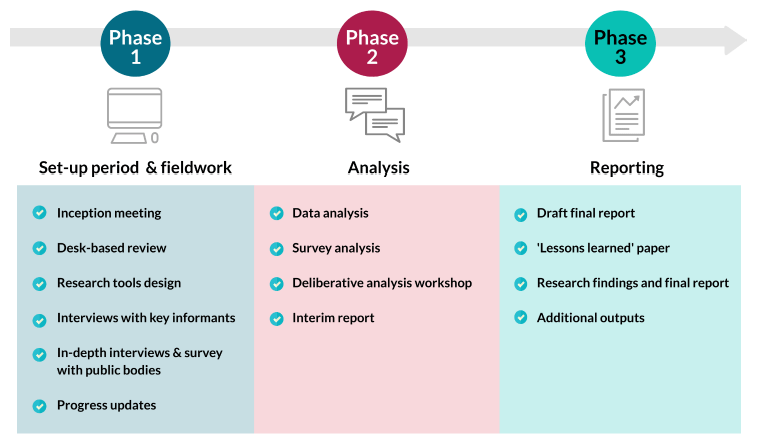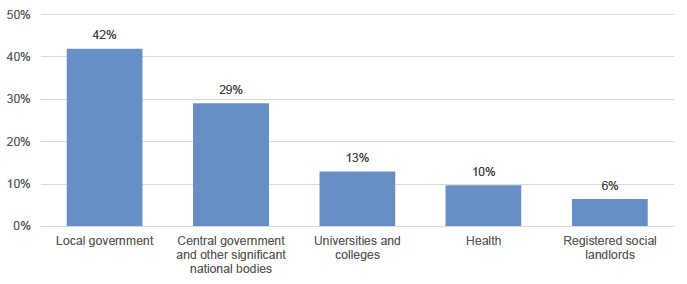Sustainable procurement duty - impact and value analysis: main report
Analysis of the impact and value of the sustainable procurement duty in procurement.
Chapter 1: Introduction and context
Blake Stevenson Ltd was commissioned by the Scottish Government to undertake analysis of the impact and value of the Sustainable Procurement Duty (‘the Duty’) which is laid out in the Procurement Reform (Scotland) Act 2014.
Sustainable procurement can be defined as the pursuit of sustainable development objectives through the purchasing and supply process. Sustainable procurement aims to make the best use of public money, helping the government achieve its overarching purpose and strategic objectives.[1]
The Duty[2] (illustrated in Figure 1.1) requires public bodies[3] to consider how they can achieve improvements in the social, environmental and economic wellbeing of the area in which they operate, with a particular emphasis on reducing inequality. It also requires public bodies to think about how procurement processes can facilitate the involvement of small and medium enterprises (SMEs), third sector bodies and supported businesses and how public procurement can be used to promote innovation. Public bodies must then ensure that they act, when implementing procurement exercises, with a view to securing the intended benefits.[4]

Purpose of the research
This research will provide the Scottish Government with evidence of the ways in which the Duty is contributing to Scotland’s overarching purpose by contributing to individual national outcomes.[5] It will also provide information on the opportunities and barriers which affect the implementation of the Duty by public bodies.
The key objectives of the research included the following:
- collection and analysis of qualitative and quantitative data including evidence of the following:
- how, and to what extent, public bodies are using procurement to improve the economic, social and environmental wellbeing of their area (which must include analysis of how fair work practices are being addressed, and if bodies are paying the real Living Wage, promoting equality and tackling inequality for those working on public contracts)
- othe extent to, and ways in, which public bodies are supporting SMEs, third sector bodies and supported businesses to be involved in procurement processes
- how public bodies are promoting innovation
- impact of community benefit requirements on employment and skills, and any sub-contracting opportunities and ways in which this is benefiting priority groups
- other community benefits
- how public bodies are using public procurement to impact on environmental wellbeing
- the contribution of the Duty to the delivery of policy intentions
- contribution of public bodies to the achievement of the national outcomes through procurement.
- provision of recommendations on actions required at national, sectoral, and local levels to improve how public bodies can demonstrate their compliance with the Duty and impact on national outcomes.
- provision of recommendations on how the impact of sustainable public procurement should be evaluated on an ongoing basis (short, medium and long term)
Context for the research
There is a desire by the Scottish Government to gain a clearer understanding of how public bodies are implementing the Duty in practice. This research provides an evidence base to enhance understanding.
The Procurement Reform (Scotland) Act 2014 is a significant element of the work achieved so far in the reform of public procurement in Scotland.[6]
Within the Act, the Scottish Government emphasises sustainable public procurement. The Duty, outlined in the Procurement Reform (Scotland) Act 2014, section 9,[7] aims to make the best use of public money and aligns with Scotland’s overarching purpose and strategic objectives. The Duty aligns with the National Performance Framework and Scotland’s Economic Strategy.[8]
Scotland’s National Performance Framework sets out national outcomes with the aim of:[9]
- creating a more successful country;
- giving opportunities to all people living in Scotland;
- increasing the wellbeing of people living in Scotland;
- creating sustainable and inclusive growth; and
- reducing inequalities and giving equal importance to economic, environmental and social progress
The National Performance Framework aims to encourage everyone in Scotland to work together to achieve national outcomes. This includes national and local government, businesses, voluntary organisations and people living in Scotland. Procurement practices have a role to play in achieving the national outcomes.[10]
The Duty aims to contribute towards the achievement of the national outcomes, as well as helping public bodies to achieve local outcomes and implement local policies.
The Duty requires public bodies to consider sustainability in all purchases of £50,000 and above for goods and services, rising to £2,000,000 and above for works. The Duty requires a public body to consider, before carrying out a regulated procurement, how it can improve the economic, social and environmental wellbeing in its area, facilitate the involvement of SMEs,[11] third sector bodies and supported businesses, and promote innovation. It must then, act with a view to securing the intended benefits.[12]
Public bodies that envisage having £5 million or greater procurement spend in the next financial year must prepare a procurement strategy. This must outline how the public body intends to carry out regulated procurements, including its plans for complying with the Duty.[13] It also must prepare an annual report on its regulated procurement activities.[14] The Scottish Government provides support and guidance, including a set of sustainable procurement tools, to help public bodies comply with the Duty.
The sustainable procurement duty tools were created to help organisations embed sustainability into their procurement process by ‘identifying and addressing how they can optimise the economic, social and environmental outcome of their procurement activity’.[15] Table 1.1 details the four mains tools the Scottish Government has developed to aid the sustainable procurement process.
Scottish public procurement prioritisation tool (SPPPT) |
The prioritisation tool was developed to bring a standard structured approach to the assessment of spend categories. The risk and opportunity approach enables resources to be focused on achieving and measuring social benefits such as the creation of employment and training opportunities, whilst driving innovation. It may support annual procurement strategy refreshes. |
|---|---|
Sustainability test |
The sustainability test was designed to help embed relevant and proportionate sustainability requirements in the development of frameworks and contract. It is a quick test and may be used as a standalone product or in conjunction with the SPPPT. |
Life cycle impact mapping |
This tool is used to identify environmental and social impacts of raw materials, manufacturing and logistics, use and disposal or end of life management at each stage in the product or service and address these in the procurement process. This method can be applied to categories before undergoing the prioritisation methodology or sustainability test. |
Flexible framework assessment tool |
This is a self-assessment tool that can be used to assess current levels of performance and the actions required to embed good procurement practice to realise intended sustainable outcomes. |
In addition to the sustainable procurement tools, the Scottish Government provides guidance to help public bodies take a relevant and proportionate approach to embed sustainable actions in procurement processes. The guidance covers a range of 14 socio-economic and environmental factors including communities, equality, fair work, climate change, and biodiversity.
The Duty also focuses on economic wellbeing and inclusion, supported by the fundamental principles of equal treatment and proportionality. This includes facilitating access and removing barriers to participation by small firms and the self-employed, third sector bodies and supported businesses.[16] One example would be keeping costs associated with submitting a tender to a minimum.
Promoting innovation is another core element of the Duty. Innovation in public procurement gives a public body the opportunity to influence the market towards innovative solutions. Public bodies can promote innovation through the development of requirements and in the tendering process.[17]
Community benefits
Community benefit requirements are a subset of sustainable procurement and are defined in the Procurement Reform (Scotland) Act 2014 as a contractual requirement imposed by a public body:[18]
a) relating to:
- training and recruitment
- availability of sub-contracting opportunities
b) or which is otherwise intended to improve the economic, social or environmental wellbeing of the body’s area in a way additional to the main purpose of the contract in which the requirement is included
Community benefits have been a key strand of procurement policy and practice in Scotland since 2008.[19] The Procurement Reform (Scotland) Act 2014, Section 25, stipulates that where a public body is to tender a contract valued at £4 million or above, it must consider during the design of the tender whether or not to include community benefit requirements. The momentum behind the use of community benefit requirements “has mainly come from public sector organisations, but increasingly many contractors are also keen to commit to community benefit requirements as they align with and demonstrate contractors’ wider commitment to society and enable them to deliver on their Corporate Social Responsibility (CSR) agenda”.[20]
In 2015, the Scottish Government commissioned research to analyse the impact and value of community benefit requirements in procurement. This was conducted by the Training and Employment Research Unit (TERU) at the University of Glasgow.[21] The research aimed to assess the application of community benefit requirements and the impact these have on employment and skills development. TERU’s research found that community benefit requirements had contributed to a range of national and local outcomes relating to employability, skills and tackling inequalities by focusing on under-represented groups.
Community benefit requirements may not always be appropriate and a public body must consider the nature of the contract, its duration and local factors. In line with the Duty, community benefit requirements should be used in instances where a risk and opportunity assessment identify they are appropriate.
At the time, TERU’s research confirmed that community benefits contribute to four national outcomes:[22]
- national outcome 2: we realise our full economic potential with more and better employment opportunities for our people
- national outcome 3: we are better educated, more skilled and more successful, renowned for our research and innovation
- national outcome 4: our young people are successful learners, confident individuals, effective contributors and responsible citizens
- national outcome 7: we have tackled the significant inequalities in Scottish society
Ninety-four organisations participated in a survey conducted by TERU to inform the research. Two-thirds of the organisations had community benefit requirements in their contracts. Of the 62 organisations that had used community benefit requirements, only 16 had used them routinely with the remaining 46 organisations using them only on some of their contracts. In addition, among the organisations surveyed, 85% had at least one policy or structure in place to support the use of community benefit requirements. All responding local authorities (18) and urban regeneration companies (3) used community benefit requirements either routinely or in some contracts.
However, a number of organisations that took part in the survey did not include community benefit requirements, including 54% (14) of government agencies and 69% (11) of universities and colleges. At the time, the main reasons identified for not using community benefit requirements were:
- they were not judged relevant to the types of contract being awarded by a body
- practical concerns about the management of community benefit requirements
- lack of awareness of community benefits
- a lack of clarity about the legality of using community benefit requirements[23].
TERU’s research found that community benefit requirements were increasingly being included in the procurement process. Targets around job opportunities, apprenticeships, work placements and training for priority groups being exceeded. However, the research also concluded that there was still scope to build further awareness and understanding.
Following TERU’s research, statutory guidance for community benefit requirements for procurement contracts equal to or more than £4 million was established. The statutory guidance sets out:
- consultation that should take place before a public body determines whether or not to include community benefit requirements in a contract to which section 25 of the 2014 Act applies
- the information that should be contained in a contract notice and award notice in relation to community benefit requirements
- the circumstances in which inclusion of community benefit requirements would or would not be appropriate
This current research will explore the extent of progress made in delivering community benefits through procurement since the TERU report, and consider the impact of the Duty more widely.
Research approach
In order to undertake robust analysis of the impact and value of the Duty, we applied a range of methodological approaches. Our methodology for the research is illustrated in Figure 1.2.

Survey of public bodies
We conducted a survey of public bodies that submitted procurement reports in 2018 and additional organisations that had not done so.
The survey explored experiences of implementing the Duty and barriers and challenges to doing so. It also explored the need for additional support to improve implementation and impact.
We received 33 responses to the survey from 31 public bodies.[24] A breakdown of the responding organisations by sector is shown in Figure 1.3.

Follow-up calls
We conducted follow-up telephone calls with five survey respondents to gather additional understanding in key areas or to fill any gaps.
Qualitative analysis of 2017-18 and 2018-19 procurement reports
We undertook qualitative analysis of information provided in public bodies’ 2017-18 and 2018-19 annual procurement reports on compliance with the Duty. These reports are published online and are publicly available. The analysis focused on the 2017-18 reports as a full set of 2018-19 annual procurement reports was not available at the time we carried out this desk-based review element of this study. However, where possible and appropriate, we have included information from 2018-19 procurement reports that became available later in the study.
In-depth interviews
We conducted 11 in-depth interviews with senior procurement staff from a sample of public bodies across Scotland. The interviewees represented a range of public bodies including five local authorities, three central government or other national bodies, two health bodies and one university. The interviews were an opportunity to:
- explore, in greater depth, the organisation’s approach to implementing the Duty
- explore the impact of the Duty and discuss examples of good practice
- identify any barriers to successful implementation
Key informant interviews
We conducted 12 key informant interviews with individuals who have in-depth knowledge and experience of the Duty. These included representatives within the Scottish Government and in other parts of the public and third sector.
Referencing
Throughout the report, we provide examples and quotes from public bodies. We specify if these are taken from survey respondents, interviewees or public bodies’ annual procurement reports. In some cases, public bodies’ 2017-18 and/or 2018-19 reports are no longer available online. Where the annual procurement reports are available online, we name the public body and provide a link to the report. In cases where the information is taken from a survey response or an interviewee, or where it is taken from an annual procurement report that is not available online, the information has been anonymised.
Methodological limitations
The analysis we have undertaken has only been able to take account of the information that was available at the time of the research. Some public bodies did not submit annual procurement reports in 2017-18 and/or 2018-19 and any community benefits or other outcomes achieved through their procurement activity has not been reflected in this report. While a substantive amount of information has been analysed, this is not a complete picture of sustainable procurement activity in Scotland.
In addition, while we make comparisons and highlight progress made between 2017-18 and 2018-19 where possible, we cannot always compare the data provided by public bodies in 2017-18 with the data provided in 2018-19. This is because the data was not collected in a consistent manner in the two years. In 2017-18, public bodies largely had the discretion to decide which quantitative data they provided about their procurement activity, and the format they provided it in. In 2018-19, the Scottish Government asked all public bodies to complete a data template with standardised questions. This allows for more comparison between and across public bodies and, assuming that public bodies complete a similar template in their 2019-20 reports, the template will allow more comparisons to be made over time when the 2019-20 reports are available.
Contact
Email: socialresearch@gov.scot
There is a problem
Thanks for your feedback